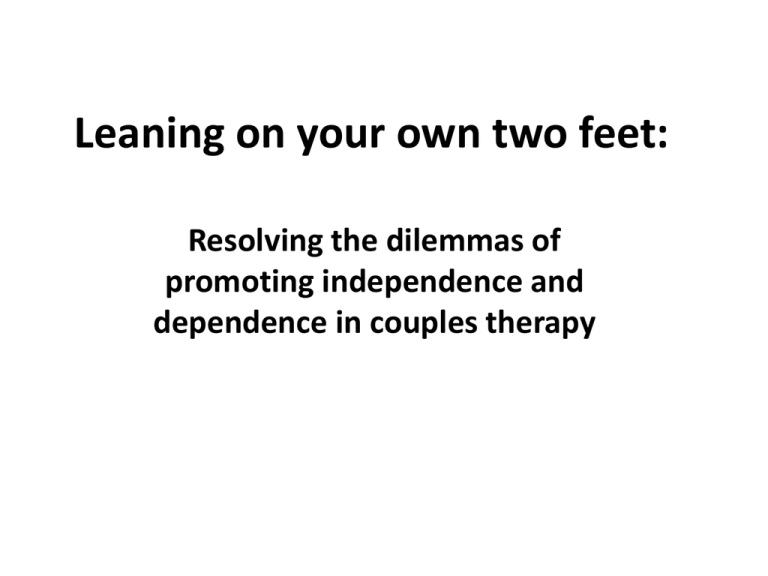
Leaning on your own two feet:
Resolving the dilemmas of
promoting independence and
dependence in couples therapy
• Bruce’s confusion
• Standing up for himself
Vs
empathising and caring
In practice he found these approaches worked
against each other much of the time.
• If you become too dependent on your
loved ones, you may become less effective
in your wider relationships and activities.
• In order to truly love another person you
must first learn to love yourself
• We must mature as individuals in order to
improve our relationship, not the other
way around.
The Age Old Argument
The Intrapsychic Vs Interpersonal
The Attachment Movement
The Systems Movement
Object Relations Vs Attachment
SELF IN RELATION TO OTHERS
“There is no such thing as a child” (Winnicott, 1965)
There is no such thing as an individual.
Internal Working Model of Self and Other (Bowlby)
Corollary for Individual Wellbeing
Feeney’s study
In Couples Therapy
Approaches that emphasise promoting
individual growth VS
Approaches that emphasise promoting the
growth of mutuality and dependence in the
relationship
Exemplified by the approaches of David
Schnarch and Susan Johnson
David Schnarch
• Passionate Marriage, Crucible Approach
• Reflected Sense of Self
• Emotional Gridlocks – crystalised by competing
and mutually exclusive need eg.
• Bring Focus to own part in gridlock
• Emotional differentiation
• Bowenian approach to increasing anxiety
tolerance to favour personal integrity over
relationship equlibrium
• Growth Cycle
• Self Validated Intimacy
• Two-Choice Dillemmas
• Acting from the best part of oneself
Susan Johnson – Emotionally Focussed
Therapy for Couples
• Safe Haven and Secure Base function of couple
• Difficulties due to defensive secondary emotions
and reactions
• If primary emotions (attachment related
emotions) are brought into relationship and met
by partner, therefore problems will lessen
• Engaging Withdrawer
• Softening of Blamer
• Reaching Out to Spouse
• Intimacy
Common Attachment Fears
Common Attachment Needs
being rejected
acceptance
being abandoned
Closeness
Not measuring up, being a failure
understanding
Not being accepted or valued
To feel important
Being unlovable
To feel loved
Being over-controlled
Boundaries, differentiation
Being burdened by other’s needs
•
•
•
•
•
•
•
•
•
•
•
•
•
STAGE ONE: DE-ESCALATION
1. Assessment
2. Identify negative cycle / Attachment issues
3. Access underlying attachment emotions
4. Frame problem – cycle, attachment
needs/fears
STAGE TWO – RESTRUCTURING THE BOND
5. Access implicit needs, fears, models of self
6. Promote acceptance by other – expand dance
7. Structure emotional engagement – express
attachment needs.
STAGE THREE: CONSOLIDATION
8. New positions / cycles – enact new stories –
of problems and repair
• 9. New Solutions to pragmatic issues
Two paths to an Agentic Self
- continuous acts of risking separateness
- experiencing self-definition through empathic attunement
and mirroring by an important other
Making Bridges
• Feeney (et,al 2008) demonstrated that a person’s
attachment style determines how they engage in and shape
new relationships with people – in both social and work
environments.
• Secure attachment (AAI) protects adolescents from risktaking behaviour (Wills & Cleary 1996)
• Adolescents with secure attachment patterns with their
parents are more able to launch and create interdependent
adult relationships (Allen&Land 1999, Noom et,al 1999).
• Adults who experience secure and reliable dependence
with their spouse are more able to explore and perform
independently away from their spouse (Feeney,2007;
Elliott, 2003).
Secure Base, Springboard to Explore
Dillemmas For Therapists and Clients
• How much do I take a stand for my own
personal integrity? How much do I care for
and validate my partner’s competing needs?
• How much do we encourage our clients to
take a stand for their personal integrity? How
much do we encourage our clients to care for
and validate their partner’s competing needs?
• When do we change from one approach to
the other? Why do we? Why would we expect
clients to not become confused?
• Lisa and Brad had rarely had sex in the last ten years of their twenty year marriage.
Brad was the more dejected by the standoff. Lisa felt bitter about it as well but was
ambivalent as to whether she could find herself wanting Brad the same way she
once did.
• Lisa felt resentful at Brad’s tentative and “unmanly” attempts to skirt the subject.
She harboured an accumulated resentment that Brad needed her to be in a
burdensome mother position, always having to make him okay. She was also left
feeling disappointed that he would give up so easily, wishing someone would
continue to want her regardless of any obstacles she might place in their way. In
other words, Lisa wanted sex but only if Brad wanted her the way she wanted him
to want her.
• The lack of resolution tacitly suited Lisa. By not effectively and openly wanting sex
herself, she did not have to confront her anxiety about facing the needs of
important others; a situation she had learned from childhood to be burdensome.
• Brad, on the other hand, desperately wanted more sex and general closeness but
was vigilant of Lisa’s criticisms. Moreover, the pain of rejection was something that
he learned to avoid. He only approached the subject indirectly, unwittingly
guaranteeing Lisa’s annoyance. In short, he needed Lisa’s permission before he
would want openly.
• The lack of resolution tacitly suited Brad. By not effectively and actively wanting
intimacy, he did not have to confront his anxiety about being criticised or rejected.
Indeed he had learned from childhood that confronting an important other with his
needs risked a schism in his attachment – a scary and disorganising experience for
Brad.
• The situation came to a head when Lisa began to experience the attractions of men
at her workplace.
DISCUSS
Focus on the Individual
VS
Focus on the relationship
•
•
•
•
•
•
•
•
•
•
•
Leaning
On
Your
Own
Two
Feet
1) ability to mentalize - perceiving with accuracy the intention behind the
other person’s defensive behaviour, understanding your own reactions
and the intention behind them as well as how the other person
experiences these
2) emotionally differentiation, internal sense of self
3) Solomon – becoming an expert at providing partner experience of being
loved – knowing what particular attachment need spouse is trying to get
met and getting good at addressing them
4) strategic accessing of spouse for self-object needs
5) able to soothe through the other and by self
6) meta-communication
7) (for the therapist) not requiring radical alteration of people’s
schemas/IWMs – not trying to change dismissive into a preoccupied – the
IWM IS the secure base – i.e dismissive style is safe – makes the world
predictable
More important to promote acceptance of the other person’s style, needs,
and vulnerabilities (no.3 above), and to reach out for own needs (no. 4
above)
Persist in wanting especially when the other does not want you to want
Freud – a need acknowledged is more important than a need met
Solomon – meeting relational need of other 1st in order to get what you
need from the other – not visa versa
INTERLOCKING VULNERABILITIES
Surface Behaviour &
Non-Verbals
Surface Behaviour &
Non-Verbals
Underlying Feelings &
Vulnerabilities
Underlying Feelings &
Vulnerabilities
Facilitating MetaConversations
Lisa, in counselling, talked about her anxiety around somebody else being
needy. She was able to connect this to her childhood experience of feeling
burdened by the neediness of her mother, and resentment at having to be
the functional one for them both. On hearing this Brad could see that her
prickliness was not actually about him. He could afford to be less
defensive and could afford to become empathetic about her feelings.
Brad wanted Lisa to understand how he felt about her stonewalling his
attempts for closeness and her withering dismissive behaviour.
He opened by saying he wanted to talk about his despair at feeling blocked.
Lisa’s eye-raising non-verbals had the potential to derail him, but he kept
in mind his insight that Lisa pushed back when she felt anxious.
By keeping an awareness of Lisa’s anxiety and activated vulnerabilities, he was
able to maintain his equilibrium (Schnarch’s, 2002, “holding onto
yourself”) and persist. He was even able to let her have her defensive
response – as an understandable expression of her vulnerability of feeling
burdened by the other- without reacting back to her.
By experiencing that Brad did not require her to be different while he was
authentically expressing his softer vulnerabilities, Lisa was able to engage
with Brad’s experience. This time, she didn’t feel she was going to get
lumped with making him okay.
SEX!
• Schnarch and sexual desire
VS
Johnson and sexual desire
Esther Perel
• Need distance, need to be a stranger in some
sense to our partner
• Warmth and emotional intimacy is not
correlated with more satisfactory sex
• Need to accommodate love, warmth, affection
AS WELL AS anger, hatred, desire to hurt and
annihilate the other (at a psychic level)
Eagle 2007
The attachment system is entirely separate from
the sexual system, AND that they –at least
partially – are antagonistic to each other.
The more secure and safe we try to make our
relationships, the less desire is found.
SEX = MADNESS
Fonagy 2008:- we are all prone to borderline mental
states when it comes to sex
- The emotional roller coaster
- Feelings spinning out of control
- Idealization of the other
- Loss of boundariedness, identity diffusion
- Explicit and implicit controlling an manipulation of
proximity
- Loss of sense of the other as separate from the erotic
object
Developmental absence of mirroring with sexual
experience.
“…..uncontained self-states create disorganisation within
the self and have to be projected out to be regulated.”
Dangers of valuing one approach to sex over
others.
The IWM/ attachment style IS the persons’s
secure base
Solomon - getting partners to respond to each
person’s attachment needs – experientially,
including the avoidant’s
C.F. “engaging the withdrawer”
Fonagy - The embodiedness of the mind – not
all psychic matter is interelational
Two paths to an Agentic Self
continuous acts of risking
separateness and selfdefinition
Continuous acts of risk
taking and self definition
VS
experiencing self-definition
through empathic
attunement and mirroring
by an important other
Experiencing self definition
through empathetic
attunement and mirroring
by an important other
Sex as the prime exemplar
Fonagy – because sexual experience is not mirrored
back early in life, it becomes disembodied and
must projected outward and experienced as if the
other is having that experience, at least in the
fantasy mind of the projector. By the other being
open to contain that sexual experience, it can be
mirrored back and reintegrated by the projector.
Both solid self and secure attachment essential
Differences between men and women
Personal robustness and relationship security necessary for one partners to
initiate and for partners to consider being the container of the other’s
sexual desire and to allow themselves to resonate with that sexual desire
Partners need robustness and boundaries to consider being a receptacle of
erotic advances without becoming preoccupied by negative meanings that
they may be prone to place on their partner’s advances
Sensate focussed activities are useful in practicing this robustness and
boundaries in a graded, calibrated steps.
Partner Shaping – the trap of the Spontaneity Command
Solomon – meeting the erotic need of other 1st in order to get what you
need from the other – not visa versa
Mentalizing
One Couple’s Homework
• She was to ask for sexual touch and to draft a
statement for him to repeat that expressed desire
and wanting. They were not allowed to proceed
to intercourse during this exercise.
• He was to seek out non-sexual touch (foot rub)
and focus on his own enjoyment. He was to just
notice when his thoughts turned to whether she
was resentful or unhappy with the activity,
question these meanings, and return his focus to
the touch and the pleasure of it.
The Erotic Mind
• Fonagy and associates – The Ontological Stage
of Mentalization Development
• Allowing the Erotic to be held in m ind and in
fantasy and to be shared and experienced in
the relationship in this way
• More flexibility for a couple, less
powerlessness
Failures in Mentalization (Fonagy et.al 2008)
Psychic Equivalence Mode
World=Mind, ideas are too “real”
constructs are not distinguished from external reality that
they represent eg. dreams, flashbacks, paranoid delusions
Pretend Mode
ideas are not real enough
authentic feelings do not accompany thoughts
Feelings and thoughts are role-played
can make wild assumptions about mental states of others,
“hypermentalizing” “destructively inaccurate mentalizing”
Teleological Mode
Mental states are compulsively acted out
Only actions and their tangible effects count
eg. self harm, violence
• Lisa and Brad had rarely had sex in the last ten years of their twenty year marriage.
Brad was the more dejected by the standoff. Lisa felt bitter about it as well but was
ambivalent as to whether she could find herself wanting Brad the same way she
once did.
• Lisa felt resentful at Brad’s tentative and “unmanly” attempts to skirt the subject.
She harboured an accumulated resentment that Brad needed her to be in a
burdensome mother position, always having to make him okay. She was also left
feeling disappointed that he would give up so easily, wishing someone would
continue to want her regardless of any obstacles she might place in their way. In
other words, Lisa wanted sex but only if Brad wanted her the way she wanted him
to want her.
• The lack of resolution tacitly suited Lisa. By not effectively and openly wanting sex
herself, she did not have to confront her anxiety about facing the needs of
important others; a situation she had learned from childhood to be burdensome.
• Brad, on the other hand, desperately wanted more sex and general closeness but
was vigilant of Lisa’s criticisms. Moreover, the pain of rejection was something that
he learned to avoid. He only approached the subject indirectly, unwittingly
guaranteeing Lisa’s annoyance. In short, he needed Lisa’s permission before he
would want openly.
• The lack of resolution tacitly suited Brad. By not effectively and actively wanting
intimacy, he did not have to confront his anxiety about being criticised or rejected.
Indeed he had learned from childhood that confronting an important other with his
needs risked a schism in his attachment – a scary and disorganising experience for
Brad.
• The situation came to a head when Lisa began to experience the attractions of men
at her workplace.







